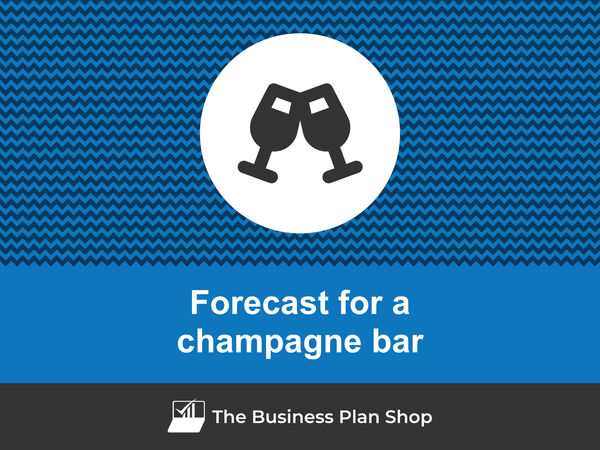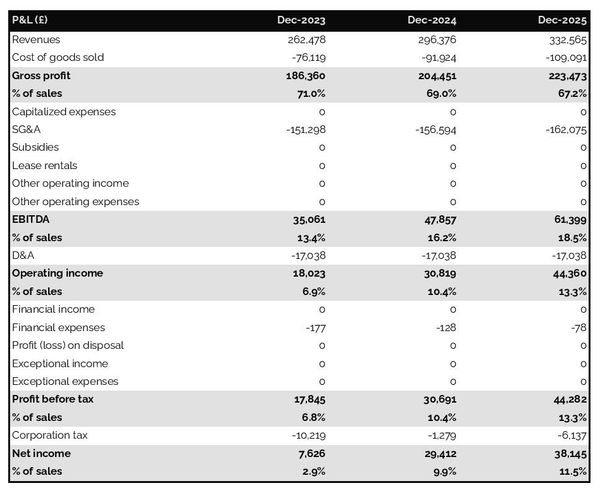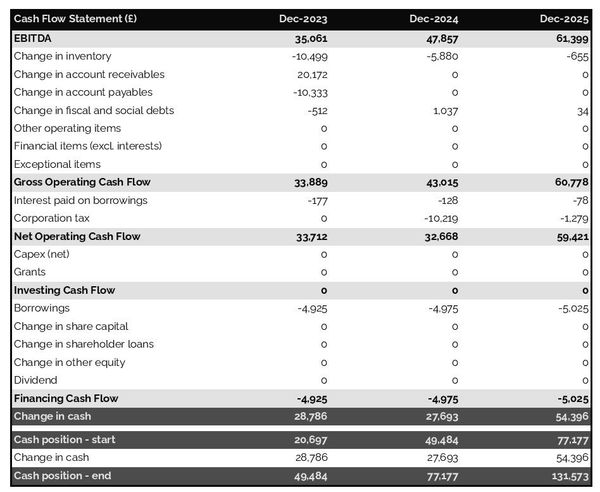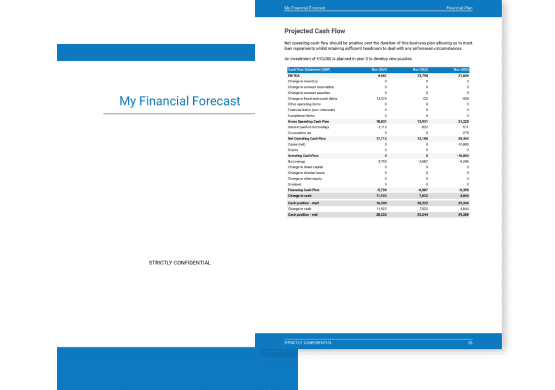How to create a financial forecast for a champagne bar?

Developing and maintaining an up-to-date financial forecast for your champagne bar is key in order to maintain visibility on your business’s future cash flows.
If you feel overwhelmed at the thought of putting together a champagne bar financial forecast then don’t worry as this guide is here to help you.
We'll cover everything from: the main objectives of a financial forecast, the data you need to gather before starting, to the tables that compose it, and the tools that will help you create and maintain your forecast efficiently.
Let's get started!
Why create and maintain a financial forecast for a champagne bar?
Creating and maintaining an up-to-date financial forecast is the only way to steer the development of your champagne bar and ensure that it can be financially viable in the years to come.
A financial plan for a champagne bar enables you to look at your business in detail - from income to operating costs and investments - to evaluate its expected profitability and future cash flows.
This gives you the visibility needed to plan future investments and expansion with confidence.
And, when your trading environment gets tougher, having an up to date champagne bar forecast enables you to detect potential upcoming financing shortfalls in advance, enabling you to make adjustments or secure financing before you run out of cash.
It’s also important to remember that your champagne bar's financial forecast will be essential when looking for financing. You can be 100% certain that banks and investors will ask to see your numbers, so make sure they’re set out accurately and attractively.
Need a solid financial forecast?
The Business Plan Shop does the maths for you. Simply enter your revenues, costs and investments. Click save and our online tool builds a three-way forecast for you instantly.

What information is used as input to build a champagne bar financial forecast?
A champagne bar's financial forecast is only as good as the inputs used to build it.
If you are creating (or updating) the forecast of an existing champagne bar, then you mostly need your accounting information, key historical operating non-financial data, and your team’s input on what to expect for the coming years.
If you are building financial projections for a champagne bar startup, you will need to have done your research and have a clear picture of your competitive environment and go-to-market strategy so that you can forecast sales accurately.
For a new venture, you will also need a precise list of the resources needed to keep the champagne bar running on a day-to-day basis and a list of the equipment and expenditures required to start the business (more on that later).
Let's now take a closer look at the elements that make up your champagne bar's financial forecast.
The sales forecast for a champagne bar
From experience, it usually makes sense to start your champagne bar's financial projection with the revenues forecast.
The inputs used to forecast your sales will include the historical trading data of your champagne bar (which can be used as a starting point for existing businesses) and the data collected in your market research (which both new ventures and existing businesses need to project their sales forward).
Your champagne bar's sales forecast can be broken down into two key estimates:
- The average price
- The number of monthly transactions
To assess these variables accurately, you will need to consider the following factors:
- The seasonal demand for champagne may affect your average price and number of monthly transactions. For example, during the holiday season, demand for champagne may increase, allowing you to charge a higher price and potentially increase your number of transactions.
- The popularity of champagne cocktails may also impact your average price and number of monthly transactions. If champagne cocktails are in high demand, you may be able to charge a premium price and attract more customers.
- The availability of rare or vintage champagnes can also affect your average price and number of monthly transactions. If you are able to offer rare or highly sought-after champagnes, you may be able to charge a higher price and attract more customers seeking a unique experience.
- The economic status of your target market can also play a role in your average price and number of monthly transactions. If your target market consists of affluent individuals, they may be willing to pay a higher price for premium champagnes, resulting in a higher average price and potentially more transactions.
- The competition in your area can also impact your average price and number of monthly transactions. If there are several other champagne bars in close proximity, you may need to adjust your prices to remain competitive and attract customers, potentially affecting your average price and number of transactions.
Once you have a sales forecast in place, the next step will be to work on your overhead budget. Let’s have a look at that now.
Need inspiration for your business plan?
The Business Plan Shop has dozens of business plan templates that you can use to get a clear idea of what a complete business plan looks like.

The operating expenses for a champagne bar
Once you know what level of sales you can expect, you can start budgeting the expenses required to operate your champagne bar on a daily basis.
Expenses normally vary based on how much revenue you anticipate (which is why, from experience, it is always better to start your forecast with the topline projection), and where your business is based.
Operating expenses for a champagne bar will include some of the following items:
- Staff Costs: This includes salaries, wages, and benefits for your employees, such as bartenders, servers, and kitchen staff.
- Accountancy Fees: Hiring an accountant to handle your financial records and taxes can help ensure accuracy and compliance with regulations.
- Insurance Costs: Protect your business from potential risks and liabilities with insurance coverage, such as general liability, liquor liability, and workers' compensation.
- Software Licences: Utilize software to manage your inventory, track sales, and handle reservations, but be prepared to pay for the necessary licenses.
- Banking Fees: Maintain a business bank account to handle transactions and keep track of banking fees, such as monthly maintenance fees and transaction fees.
- Rent/Lease: The cost of renting or leasing your space for the champagne bar should be factored into your operating expenses.
- Utilities: Keep the lights on, the water running, and the temperature comfortable for your customers by budgeting for utility costs.
- Marketing/Advertising: Spread the word about your champagne bar through various marketing and advertising strategies, such as social media, print ads, and event sponsorships.
- Supplies: Purchase necessary supplies, such as glassware, napkins, and straws, to keep your bar running smoothly and efficiently.
- Inventory: Keep your champagne bar stocked with inventory by budgeting for the cost of purchasing wine, champagne, and other ingredients for cocktails.
- Cleaning/Maintenance: Keep your space clean and well-maintained for your customers by budgeting for cleaning supplies and maintenance services.
- Licenses/Permits: Make sure your champagne bar is operating legally by obtaining necessary licenses and permits, such as a liquor license and health permit.
- Credit Card Processing Fees: Be prepared to pay fees for processing credit and debit card payments from customers.
- Professional Services: Consider hiring consultants or other professionals to help with aspects of your business, such as menu design or interior design.
- Entertainment: If you plan on having live music or other entertainment at your champagne bar, budget for the cost of hiring performers and sound equipment.
This list will need to be tailored to the specificities of your champagne bar, but should offer a good starting point for your budget.
What investments are needed to start or grow a champagne bar?
Creating and expanding a champagne bar also requires investments which you need to factor into your financial forecast.
Capital expenditures and initial working capital items for a champagne bar could include elements such as:
- You will need to purchase a champagne bar-specific refrigeration unit to keep your bottles at the ideal temperature. This could include a wine fridge or a champagne bucket cooler.
- Investing in high-quality glassware is important for a champagne bar. This could include champagne flutes, coupes, and stemless glasses.
- A bar cart or trolley is a useful piece of equipment for serving and displaying your champagne bottles and glassware.
- A champagne opener, or sabre, is a unique and impressive tool for opening champagne bottles in front of customers.
- Furniture and decor items such as seating, tables, lighting, and wall art are crucial for creating an inviting and upscale atmosphere in your champagne bar.
Again, this list is not exhaustive and will need to be adjusted according to the circumstances of your champagne bar.
Need a convincing business plan?
The Business Plan Shop makes it easy to create a financial forecast to assess the potential profitability of your projects, and write a business plan that’ll wow investors.

The financing plan of your champagne bar
The next step in the creation of your financial forecast for your champagne bar is to think about how you might finance your business.
You will have to assess how much capital will come from shareholders (equity) and how much can be secured through banks.
Bank loans will have to be modelled so that you can separate the interest expenses from the repayments of principal, and include all this data in your forecast.
Issuing share capital and obtaining a bank loan are two of the most common ways that entrepreneurs finance their businesses.
What tables compose the financial plan for a champagne bar?
Now let's have a look at the main output tables of your champagne bar's financial forecast.
The profit & loss forecast
The forecasted profit & loss statement will enable you to visualise your champagne bar's expected growth and profitability over the next three to five years.

A financially viable P&L statement for a champagne bar should normally show:
- Sales growing above inflation
- Stable or expanding (ideally) profit margins
- A net profit
This will of course depend on the stage of your business: a new venture might be loss-making until it reaches its breakeven point in year 2 or 3, for example.
The projected balance sheet
Your champagne bar's projected balance sheet provides a snapshot of your business’s financial position at year-end.
It is composed of three types of elements: assets, liabilities and equity:
- Assets: represent what the business possesses including cash, equipment, and accounts receivable (money owed by clients).
- Liabilities: represent funds advanced to the business by lenders and other creditors. They include accounts payable (money owed to suppliers), taxes payable and loans from banks and financial institutions.
- Equity: is the combination of what has been invested by the business owners and the cumulative profits and losses generated by the business to date (which are called retained earnings). Equity is a proxy for the value of the owner's stake in the business.

The cash flow forecast
Your champagne bar's cash flow forecast shows how much cash your business is expected to consume or generate in the years to come.

It is best practice to organise the cash flow forecast by nature to better explain where cash is used or generated by the champagne bar:
- Operating cash flow: shows how much cash is generated by the operating activities
- Investing cash flow: shows how much will be invested in capital expenditure to maintain or expand the business
- Financing cash flow: shows if the business is raising new capital or repaying financiers (debt repayment, dividends)
Keeping an eye on (and regularly updating) your champagne bar's cash flow forecast is key to ensuring that your business has sufficient liquidity to operate normally and to detect financing requirements as early as possible.
If you are trying to raise capital, you will normally be asked to provide a monthly cash flow forecast in your champagne bar's financial plan - so that banks or investors can assess seasonal variation and ensure your business is appropriately capitalised.
Need a solid financial forecast?
The Business Plan Shop does the maths for you. Simply enter your revenues, costs and investments. Click save and our online tool builds a three-way forecast for you instantly.

Which tool should you use to create your champagne bar's financial forecast?
Creating your champagne bar's financial forecast may sound fairly daunting, but the good news is that there are several ways to go about it.
Using online financial forecasting software to build your champagne bar's projections
The modern and easiest way is to use professional online financial forecasting software such as the one we offer at The Business Plan Shop.
There are several advantages to using specialised software:
- You can easily create your financial forecast by letting the software take care of the financial calculations for you without errors
- You have access to complete financial forecast templates
- You get a complete financial forecast ready to be sent to your bank or investors
- You can easily track your actual financial performance against your financial forecast, and recalibrate your forecast as the year goes by
- You can create scenarios to stress test your forecast's main assumptions
- You can easily update your forecast as time goes by to maintain visibility on future cash flows
- You have a friendly support team on standby to assist you when you are stuck
- It’s cost-efficient and much cheaper than using an accountant or consultant (see below)
If you are interested in this type of solution, you can try our forecasting software for free by signing up here.
Hiring a financial consultant or chartered accountant
Hiring a consultant or chartered accountant is also an efficient way to get a professional champagne bar financial projection.
As you can imagine, this solution is much more expensive than using software. From experience, the creation of a simple financial forecast over three years (including a balance sheet, income statement, and cash flow statement) is likely to start around £700 or $1,000 excluding taxes.
The indicative estimate above, is for a small business, and a forecast done as a one-off. Using a financial consultant or accountant to track your actuals vs. forecast and to keep your financial forecast up to date on a monthly or quarterly basis will naturally cost a lot more.
If you choose this solution, make sure your service provider has first-hand experience in your industry, so that they may challenge your assumptions and offer insights (as opposed to just taking your figures at face value to create the forecast’s financial statements).
Why not use a spreadsheet such as Excel or Google Sheets to build your champagne bar's financial forecast?
You and your financial partners need numbers you can trust. Unless you have studied finance or accounting, creating a trustworthy and error-free champagne bar financial forecast on a spreadsheet is likely to prove challenging.
Financial modelling is very technical by nature and requires a solid grasp of accounting principles to be done without errors. This means that using spreadsheet software like Excel or Google Sheets to create accurate financial forecasts is out of reach for most business owners.
Creating forecasts in Excel is also inefficient nowadays:
- Software has advanced to the point where forecasting can be done much faster and more accurately than manually on a spreadsheet.
- With artificial intelligence, the software is capable of detecting mistakes and helping decision-making.
Spreadsheets are versatile tools but they are not tailor-made for reporting. Importing your champagne bar's accounting data in Excel to track actual vs. forecast is incredibly manual and tedious (and so is keeping forecasts up to date). It is much faster to use dedicated financial planning tools like The Business Plan Shop which are built specially for this.
Need a convincing business plan?
The Business Plan Shop makes it easy to create a financial forecast to assess the potential profitability of your projects, and write a business plan that’ll wow investors.

Use our financial projection templates for inspiration
The Business Plan Shop has dozens of financial forecasting templates available.
Our examples contain both the financial forecast, and a written business plan which presents, in detail, the company, the team, the strategy, and the medium-term objectives.
Whether you are just starting out or already have your own champagne bar, looking at our template is always a good way to get ideas on how to model financial items and what to write when creating a business plan to secure funding.

Takeaways
- Having a financial forecast enables you to visualise the expected growth, profitability, and cash generation for your business over the next three to five years.
- Tracking actuals vs. forecast and keeping your financial projections up-to-date is the only way to get a view on what your champagne bar future cash flows may look like.
- Using financial forecasting software is the mordern and easy way to create and maintain your forecasts.
This is the end of our guide on how to build the financial forecast for a champagne bar, we hope you found it useful. Don't hesitate to contact us if you want to share your feedback or have any questions.
Need inspiration for your business plan?
The Business Plan Shop has dozens of business plan templates that you can use to get a clear idea of what a complete business plan looks like.

Also on The Business Plan Shop
Know someone who owns or is thinking of starting a champagne bar? Share our forecasting guide with them!




